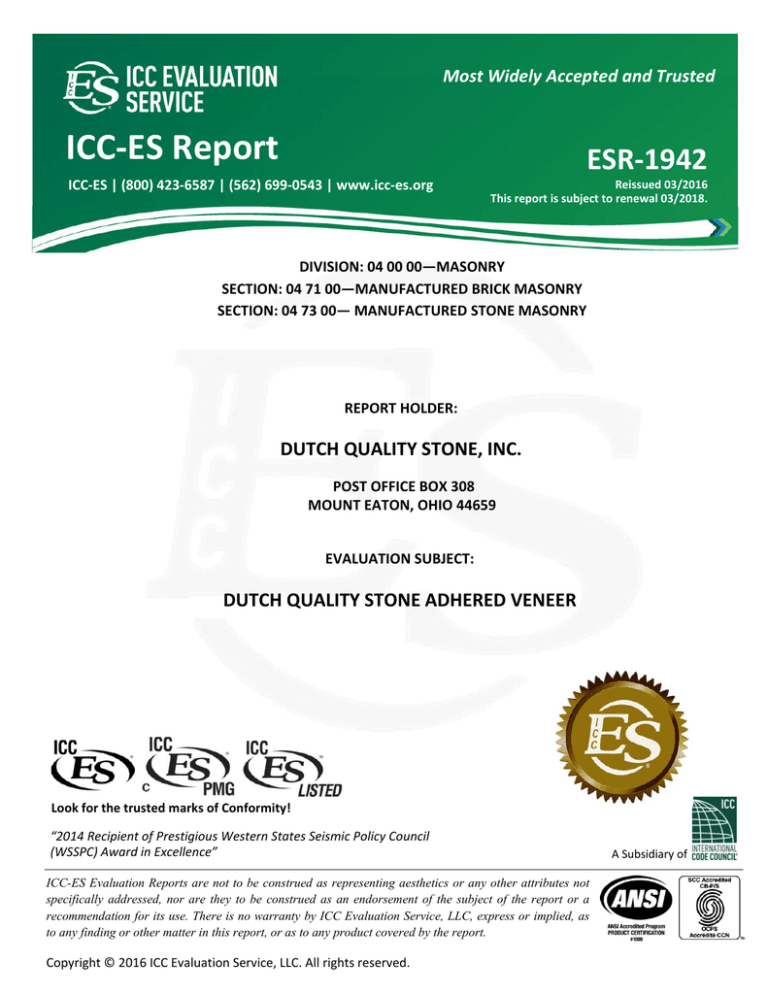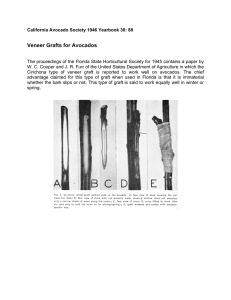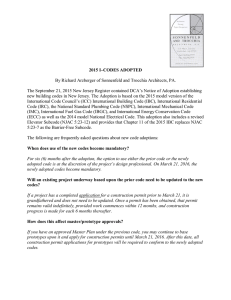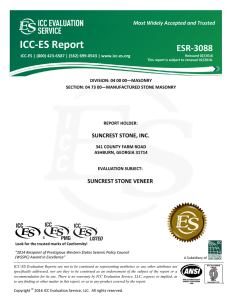
Most Widely Accepted and Trusted 0 ICC‐ES Report ESR‐1942
ICC‐ES | (800) 423‐6587 | (562) 699‐0543 | www.icc‐es.org
000 Reissued 03/2016
This report is subject to renewal 03/2018.
DIVISION: 04 00 00—MASONRY SECTION: 04 71 00—MANUFACTURED BRICK MASONRY SECTION: 04 73 00— MANUFACTURED STONE MASONRY REPORT HOLDER: DUTCH QUALITY STONE, INC. POST OFFICE BOX 308 MOUNT EATON, OHIO 44659 EVALUATION SUBJECT: DUTCH QUALITY STONE ADHERED VENEER Look for the trusted marks of Conformity! “2014 Recipient of Prestigious Western States Seismic Policy Council (WSSPC) Award in Excellence” ICC-ES Evaluation Reports are not to be construed as representing aesthetics or any other attributes not
specifically addressed, nor are they to be construed as an endorsement of the subject of the report or a
recommendation for its use. There is no warranty by ICC Evaluation Service, LLC, express or implied, as
to any finding or other matter in this report, or as to any product covered by the report.
Copyright © 2016 ICC Evaluation Service, LLC. All rights reserved.
A Subsidiary of ICC-ES Evaluation Report
ESR-1942
Reissued March 2016
This report is subject to renewal March 2018.
www.icc-es.org | (800) 423-6587 | (562) 699-0543
DIVISION: 04 00 00—MASONRY
Section: 04 71 00—Manufactured Brick Masonry
Section: 04 73 00—Manufactured Stone Masonry
A Subsidiary of the International Code Council ®
are molded and cured at the plant. Recognized patterns
are:
Patterns
REPORT HOLDER:
DUTCH QUALITY STONE, INC.
POST OFFICE BOX 308
MOUNT EATON, OHIO 44659
(877) 359-7866
www.dutchqualitystone.com
Accessories Row Locks 4x5, Row Locks 5.7, Half Brick,
Full Brick, Flat Window Trim, Jack Arch
Wings, Receptacle Block, Light Block,
Water Hydrant, Circle Vent, Arch Top Vent,
Address Block
EVALUATION SUBJECT:
DUTCH QUALITY STONE ADHERED VENEER
The veneer units are of various thicknesses, with an
average thickness for each pattern from 11/8 to 1 5/8 inches
(16 to 45 mm). The average saturated weight of the veneer
units does not exceed 15 pounds per square foot
2
(73.2 kg/m ).
1.0 EVALUATION SCOPE
1.1 Compliance with the following codes:
®
2012 International Building Code (IBC)
®
2012 International Residential Code (IRC)
2013 Abu Dhabi International Building Code (ADIBC)†
†
The ADIBC is based on the 2009 IBC. 2009 IBC code sections referenced
in this report are the same sections in the ADIBC.
Other codes (see Section 8.0)
Properties evaluated:
Veneer strength and durability
Thermal resistance
1.2 Evaluation to the following green code(s) and/or
standards:
2013 California Green Building
(CALGreen), Title 24, Part 11
Brick-Stone, Cobbled Limestone, Castle
Stone, Drystack, Fieldstone, Ledgestone,
Limestone, Split Granite, River Rock,
Stackstone, Weather Ledge, Stack Ledge,
Tuscan Ridge, Tuscany Veneer
Standards
Code
2012 and 2008 ICC 700 National Green Building
Standard™ (ICC 700-2012 and ICC 700-2008)
Attributes verified:
See Section 3.0
2.0 USES
Dutch Quality Stone Adhered Veneer is used as an
adhered, nonload-bearing, exterior veneer on nonfireresistance-rated wood-framed or light gage steel stud
walls, concrete walls or masonry walls.
3.0 DESCRIPTION
The veneer is a precast concrete product made to
resemble natural stone in color and in texture. The veneer
is composed of portland cement, aggregate, sand, water,
admixtures and mineral oxide coloring. The veneer units
The veneer units have a thermal resistance (R-value) of
0.71F ft2 h/Btu when tested in accordance with ASTM
C518 at a thickness of 1.08 inches (27 mm).
The attributes of the stone veneer have been verified as
conforming to the provisions of (i) CALGreen Section
A4.405.1.3 for prefinished building materials and Section
A5.406.1.2 for reduced maintenance; (ii) ICC 700-2012
Sections 602.1.6 and 11.602.1.6 for termite-resistant
materials and Sections 601.7, 11.601.7, and 12.1(A).601.7
for site-applied finishing materials; and (iii) ICC 700-2008
Section 602.8 for termite-resistant materials and Section
601.7 for site-applied finishing materials. Note that
decisions on compliance for those areas rest with the user
of this report. The user is advised of the project-specific
provisions that may be contingent upon meeting specific
conditions, and the verification of those conditions is
outside the scope of this report. These codes or standards
often provide supplemental information as guidance.
4.0 INSTALLATION
4.1 General:
Installation of the veneer must comply with this report, the
manufacturer’s published installation instructions, and the
applicable code. The manufacturer’s published installation
instructions must be available at the jobsite at all times
during installation.
The veneer may be applied over backings of cement
plaster, concrete, brick or concrete masonry units (CMUs).
4.2 Preparation of Backings:
4.2.1 Cement Plaster Backings: Cement plaster
backings may be applied over plywood, OSB or gypsum
ICC-ES Evaluation Reports are not to be construed as representing aesthetics or any other attributes not specifically addressed, nor are they to be construed
as an endorsement of the subject of the report or a recommendation for its use. There is no warranty by ICC Evaluation Service, LLC, express or implied, as
to any finding or other matter in this report, or as to any product covered by the report.
1000
Copyright © 2016 ICC Evaluation Service, LLC. All rights reserved.
Page 1 of 3
ESR-1942 | Most Widely Accepted and Trusted
sheathing supported by wood or steel studs; and over
concrete walls when installed as described in Sections
4.2.1.1 and 4.2.1.2.
4.2.1.1 Installation over Sheathing: The cement plaster
backing must be installed over a water-resistive barrier
complying with IBC Sections 1404.2 and 2510.6 or IRC
Sections R703.2 and R703.6.3, as applicable. Also,
flashing must be installed as required by IBC Sections
1405.4 and 1405.10.1.2 or IRC Sections R703.8 and
R703.12.2, as applicable, and weep screeds must be
installed at the bottom of the veneer. The weep screeds
must comply with, and be installed in accordance with,
IBC Section 1405.10.1.2 or IRC Section R703.12.2, as
applicable. In addition, the weep screeds must have holes
3
with a minimum diameter of /16 inch (4.8 mm) spaced at a
maximum of 33 inches (838 mm) on center, as required by
Section 6.1.6.2 of TMS 402/ACI 530/ASCE 5, which is
referenced in IBC Section 1405.10. The veneer must be
installed with the clearances required by IBC Section
1405.10.1.3 or IRC Section R703.12.1, as applicable.
Studs must be spaced no more than 16 inches (406 mm)
2
on center. Lath must be corrosion-resistant, 2.5 lb/yd
2
(1.4 kg/m ), diamond-pattern metal lath complying with
ASTM C847. The lath must be lapped in accordance with
Section 7.8 of ASTM C1063. The lath must be fastened to
each of the wall studs at 6 inches (152 mm) on center,
vertically. For wood studs, fasteners must be galvanized
nails or staples complying with Section 7.10 of ASTM
C1063 (IBC) or IRC Section R703.6.1, as applicable, and
of sufficient length to penetrate the studs a minimum of
1 inch (25.4 mm). For steel studs, fasteners must be
corrosion-resistant, self-tapping screws with a head
diameter of 7/16 inch (11.1 mm) and sufficient length to
3
penetrate the studs a minimum of /8 inch (9.5 mm).
A scratch coat of Type N or S mortar (cement plaster)
3
5
complying with ASTM C926, /8 to /8 inch thick (9.5 to 15.9
mm), must be applied over the lath and allowed to cure in
accordance with IBC Section 2512.6, before the veneer
units are applied.
4.2.1.2 Installation over Concrete: For concrete walls,
corrosion-resistant metal lath complying with ASTM C847
must be installed in accordance with Section 7.10 of ASTM
C1063, and IRC Section R703.6.1, as applicable, with
fasteners having a 1-inch (25.4 mm) minimum embedment,
at 6 inches (152 mm) on center, horizontally and vertically.
The gravity load (shear) capacity and negative wind load
(pull out) capacity of these proprietary fasteners must be
justified to the satisfaction of the code official. The scratch
coat must be applied as described in Section 4.2.1.1.
4.2.2 Masonry Backings: Brick and concrete masonry
walls must be prepared in accordance with Section 5.2 of
ASTM C926 and IBC Section 2510.7, as applicable.
4.3 Application of Veneer Units:
A 1/2-inch-thick (12.7 mm) coat of Type N or S mortar is
applied to the entire back of each piece of veneer and the
veneer is pressed in place over the scratch coat. To
ensure bond strength, the thickness, workability and
application force must result in squeeze out of the mortar
beyond the perimeter of the stone base. Joints between
veneer units are to be grouted and tooled in accordance
with the manufacturer’s published installation instructions.
5.0 CONDITIONS OF USE
The Dutch Quality Stone adhered veneer described in this
report complies with, or is a suitable alternative to what is
specified in, those codes listed in Section 1.0 of this report,
subject to the following conditions:
Page 2 of 3
5.1 Installation must comply with this report, the
manufacturer’s published installation instructions and
the applicable code. In the event of a conflict between
the manufacturer’s published installation instructions
and this report, this report governs.
5.2 The use of the precast stone veneer is limited to
installation on wood-framed, light-gage-steel-framed,
concrete or masonry walls.
5.3 Expansion or control joints used to limit the effect of
differential movement of supports are to be specified
by the architect, designer or veneer manufacturer, in
that order. Consideration must also be given to
movement caused by temperature change, shrinkage,
creep and deflection.
5.4 In jurisdictions adopting the IBC, the supporting wall
framing must be designed to support the additional
weight of the cement plaster backing, stone veneer
and mortar setting bed. Additionally, supporting
1
members must be designed to limit deflection to /600
of the span of the supporting members.
5.5 In jurisdictions adopting the IRC, where the seismic
provisions of Section R301.2.2 apply, the average
weight of the wall supporting the precast stone
veneer, including the weight of the veneer system,
must be determined. When this weight exceeds the
applicable limits of IRC Section R301.2.2.2.1, an
engineered design of the wall construction must be
performed in accordance with IRC Section R301.1.3.
6.0 EVIDENCE SUBMITTED
6.1 Data in accordance with the ICC-ES Acceptance
Criteria for Precast Stone Veneer (AC51), dated
February 2008 (editorially revised April 2012).
6.2 Report of testing in accordance with ASTM C518.
7.0 IDENTIFICATION
Each package of veneer is labeled or stamped with the
manufacturer’s name (Dutch Quality Stone), the product
name, pattern name and the evaluation report number
(ESR-1942).
8.0 OTHER CODES
8.1 Evaluation Scope:
In addition to the codes referenced in Section 1.0, the
products described in this report were evaluated for
compliance with the following codes:
®
2009 International Building Code (2009 IBC)
2009 International Residential Code® (2009 IRC)
2006 International Building Code® (2006 IBC)
®
2006 International Residential Code (2006 IRC)
The Dutch Quality Stone products described in this
report comply with, or are suitable alternatives to what is
specified in, the codes listed above, subject to the
provisions of Sections 8.2 through 8.7.
8.2 Uses:
See Section 2.0.
8.3 Description:
See Section 3.0.
8.4 Installation:
8.4.1 General: See Section 4.1.
8.4.2 Preparation of Backing:
ESR-1942 | Most Widely Accepted and Trusted
8.4.2.1 Cement Plaster Backings: See Section 4.2.1.
8.4.2.1.1 Installation over Sheathing: The cement
plaster backing must be installed over a water-resistive
barrier complying with 2009 and 2006 IBC Sections 1404.2
and 2510.6 or 2009 and 2006 IRC Sections R703.2 and
R703.6.3, as applicable. Also, flashing must be installed as
required by 2009 IBC Section 1405.4 (2006 IBC Section
1405.3) or 2009 and 2006 IRC Section R703.8, as
applicable, and weep screeds must be installed at the
bottom of the stone veneer. The weep screeds must
comply with, and be installed in accordance with, 2009 and
2006 IBC Section 2512.1.2 or 2009 and 2006 IRC Section
R703.6.2.1, as applicable. In addition, the weep screeds
3
must have holes with a minimum diameter of /16 inch
(4.8 mm) spaced at a maximum of 33 inches (838 mm) on
center, as required by Section 6.1.5.2 of TMS 402/ACI
530/ASCE 5 (Section 6.1.5.2 of ACI 530/ASCE 5/TMS
402), which is referenced in 2009 IBC Section 1405.10
(2006 IBC Section 1405.9).
For additional requirements, see Section 4.2.1.1.
Page 3 of 3
8.4.2.1.2 Installation over Concrete and Masonry: See
Section 4.2.1.2.
8.4.2.2 Masonry Backings: See Section 4.2.2.
8.4.3 Application of Veneer Units: See Section 4.3.
8.5 Conditions of Use:
See Section 5.0.
8.6 Evidence Submitted:
See Section 6.0.
8.7 Identification:
See Section 7.0.





